Tim Human explores 25 years of IR Magazine covering the biggest stories of the day
Twenty-five years ago, IR Magazine was launched with the stated aim of helping you ‘adopt the most effective communications with present and potential shareholders, and with those who influence their decisions.’
Two hundred and forty-three issues later, we take a journey through how we covered the big issues of the last quarter-century.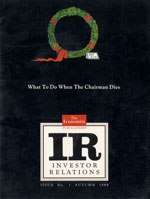 Autumn 1988: What to do when the chairman dies
Autumn 1988: What to do when the chairman dies
It’s a good marketing ploy to start off on a controversial note – and that’s just what IR Magazine (then known as Investor Relations) did in the autumn of 1988 with its first edition.
The cover story considered what a company should do if its chairman died unexpectedly, prompting a few letters of complaint from individuals who thought the subject matter distasteful. One of the complaint letters came from a member of the UK’s House of Lords who had a couple of chairman roles to his name.
The article, however, made it clear that the fate of the CEO is an issue any well-run public company should be thinking about. ‘The main point: the fate of the chief executive has inordinate implications for investor relations,’ we stated.
Summer 1990: Japanese IR
By the end of the 1980s, Japan had invested more than $300 bn in overseas markets – a figure expected at the time to rise to $2 bn by the 21st century. With all that money up for grabs, this article looked at how non-Japanese companies could go about attracting it.
One tactic was to take a listing in Tokyo. At that time, around 100 overseas firms had taken the plunge. BP, the British oil and gas company, went a step further by backing up the share sale with a full-time IRO based in the capital.
Still, many consultants saw Tokyo listings as costly and unnecessary because Japanese investors could buy the shares more cheaply overseas. ‘Yes, the decision maker for that enormous pile of money is in Tokyo. Yes, the Japanese buy great heaps of foreign equities. No, they don’t buy those equities on the Tokyo Stock Exchange,’ said one.
IR predictionsIt’s always interesting to go back and look at prior predictions for the future, if only to see how wrong they were. Back in 1993, IR Magazine’s Speculator column (which continues to this day) imagined what IR would be like in the 21st century.In fact, the then anonymous author of the column – an IRO – proved rather prophetic, seeing the role of investor relations becoming more and more complex, and as a result requiring further professionalization. ‘It has not yet become a profession in its own right,’ the author wrote. ‘I predict we shall see a strong trend in this direction in the years ahead. Who knows, eventually we might even see codes of conduct and professional qualifications.’ Nowadays, 15 students a year graduate from San Francisco’s MAIR with a master’s in IR – just one of many qualifications in investor relations now available around the world. That’s the kind of predictive power any successful equity analyst would be proud of! The author also offered the hope – with somewhat less conviction – that European firms would follow the lead of the UK and the US and introduce in-house IR specialists. At the IR Magazine Awards – Europe nowadays, it is hard for UK companies to get a look-in, given the caliber of IROs across the region. |
Summer 1994: From pariah to potential
After years of being shunned by international investors, the lifting of sanctions in September 1993 made stock pickers think again about South Africa. Confidence further improved after the country’s first universal elections were held the following April, handing the ANC a large majority. The stage was set for a comeback.
First on the agenda for South Africa was obtaining an international credit rating – a task for which it used Goldman Sachs as an adviser. Equity investment, meanwhile, looked set to skyrocket once the country was added to the portfolios of index-tracking funds.
Our article said the future looked bright for South Africa’s stocks, although we said companies would have to move away from the practice of holding their cards close to their chest, a habit formed during the years of sanctions.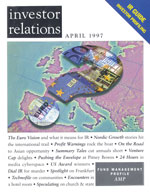 April 1997: The euro vision and what it means for IR
April 1997: The euro vision and what it means for IR
In 2012, companies are struggling to explain their plans to investors given the possibility of a country exiting the euro; it’s a tough job to keep the buy side onside with all the uncertainty.
Back in 1997, the same problem existed, but in reverse. The euro had officially been adopted in 1995, but it didn’t appear as an accounting currency until 1999, and the actual hard cash went into circulation only in 2002.
With the right message, however, companies could take advantage of the situation. For example, it was expected that the euro would prevent firms from selling goods at different prices in different markets – any differences would be obvious to consumers, making it harder for less efficient companies to compete. The job for IROs ‘will be to make sure they are in the efficient group,’ the article reported.
October 1997: Home & away – IR goes global
Late 1997 saw a frenzy of overseas spending by investors. US fund managers were keen on European industrials; French funds, meanwhile, liked Latin American privatizations. Both European and US investors pumped money into Asia. The question was: could IR professionals keep up?
They were certainly going to try. A survey by IR Magazine found companies planned to spend proportionally more time on international investors than on domestic ones.
Then, as now, they were driven by the belief that international shareholders are less fickle than their domestic colleagues and more likely to hold for longer periods. Companies also wanted to match their shareholder base to their worldwide sales. Globalization was driving global IR.
March 1998: Shattered
In the previous year, there had been much talk about IR really taking off in the Asia-Pacific region. The 1997 financial crisis – which saw South East Asia and Japan suffer collapsing currencies and stock markets – changed all that. Market commentators worried that, as no one wanted to buy stocks any more, companies would view investor relations as a waste of time, effort and money.
Andrew Pirie, a director at financial PR firm Baldwin Boyle Shand in Singapore, had hope for the future, though. ‘Companies will no longer have access to cheap debt funding – which has been the cause of much of Asia’s problems – so equity funding will become more important,’ he predicted. ‘After stamping out of the region last year, international investors are coming back.’
The IR Magazine Awards programIn 1991 IR Magazine held its first investor relations awards events at the Brewery in London’s Chiswell Street. The inaugural winner of the grand prix for ‘general excellence in investor relations’ was SmithKline Beecham, which went on to form part of pharmaceutical giant GSK.Since then, our awards program has expanded to North America (1996), Asia-Pacific (2001) and Brazil (2002). What’s more, the original UK awards are now part of the IR Magazine Awards – Europe, which cover firms from Ireland, continental Europe and the Nordic region. The awards have always been decided the same way. All we do is survey hundreds of analysts and investors to find out which firms do the best IR. Some companies have been one-hit wonders, others have displayed staying power. Perhaps the greatest ever winner is GE, which has won numerous awards over the years – which is fitting for the company that is said to have established the first ever IR department in 1953.  |
May 2001: Fighting gravity
After the internet bubble popped, many companies saw their valuations plummet and the options they had used to lure employees priced above the current share price. It was one hell of a hangover.
For instance, Outpost.com had seen its shares fall from $11 to $2 in just a couple of months. ‘I’d say my role has been expanded to include more encouragement of other employees who feel despair at the stock price,’ said IR manager Janice Simoncelli.
European companies had the same problem. In Germany, software firm SAP set up an intranet after employees showed an increasing demand for financial news about the company.
July 2001: Eastern promise
IR Magazine examined the progress of IR in emerging Europe, where Poland, Hungary and the Czech Republic were ‘forging ahead with privatizations and plans to join the EU’. The article also considered the smaller markets of Slovakia, Slovenia, Ukraine and Estonia, as well as Russia, which had just got back on its feet after its 1998 currency crisis.
The picture looked similar across the region: the biggest firms were rapidly improving their disclosure, corporate governance and accounting standards, while others were lagging far behind – or just not trying at all. ‘The larger companies have made an IR effort, the smaller ones have nothing,’ we wrote.
August 2001: Open & shut
This feature warned readers in the US that, unless they got their communications strategy in order, they could soon find themselves chatting away their careers. The reason? The introduction of Regulation FD, which required all material information to be publicly disseminated to all investors – and potential investors – at the same time, regardless of their size. While it’s never been easy working in IR, we wrote, it’s arguably never been harder, either.
How could an IRO survive this new environment? We offered a few tips. One: don’t rely on common sense – that could get you into trouble as even lawyers are unsure what you can and can’t do. And two: have your legal counsel on speed dial.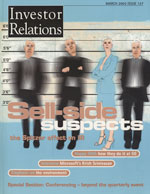 March 2003: Sell-side suspects
March 2003: Sell-side suspects
With New York’s then attorney general Eliot Spitzer and Wall Street thrashing out what would become the global settlement, IR Magazine asked market participants how they were preparing for an agreement that would surely change the sell side beyond recognition. Most expected coverage to fall, especially for small and mid-caps. Of course, they were proved correct.
Looking to the future, interviewees anticipated more independent research and closer ties between IR departments and the buy side – two other predictions that came to pass. ‘There has been a trend in which IROs have started increasing their focus on the buy side and the global settlement propels that even more,’ said John Nesbett, managing director of Lippert/Heilshorn & Associates.
September 2003: Cracks in the ceiling
We hear all the time about the glass ceiling women encounter in business. Investor relations, therefore, offers a breath of fresh air as from the outset women have been just as prominent as men in senior positions.
Our cover story explained that the IR profession found its feet around the same time women in business were finding theirs. ‘IR was a new industry without ingrained stereotypes or networks, thus enabling women to be part of its foundation,’ we wrote.
A recent study, however, shows that not all is equal in the IR profession: the IR Magazine Global Practice Report 2012 finds male IROs earn more than their female counterparts consistently across different regions and levels of seniority, so there is still progress to be made.
December 2003: Peeping through the hedge
This wasn’t a feature on noisy neighbors, but rather a look at why IROs needed to get a grip on hedge funds. At that point in time, the hedge fund industry had grown to around 7,000 in number, with assets of roughly $650 bn under management. In other words, it couldn’t be ignored any longer.
The feature’s main message was actually one that still struggles to be heard today – namely, that hedge funds aren’t all short-term, short-selling ‘highwaymen of the economy’, as Malaysian Prime Minister Mahathir Mohamad put it. Rather, there is a broad range of investment styles. With a bit of research, IR can identify which hedge funds to court – and which to be cautious of. May 2004: Double duty
May 2004: Double duty
Should the chairman and CEO roles be split between two individuals? It’s a question we’re still asking today – and investors are still asking companies. News Corp saw a major shareholder revolt over the issue at its AGM in October this year.
Back in 2004, US trade union pension funds pushed the issue up the agenda by calling for the widespread appointment of independent chairmen. The failure of WorldCom and Enron had also made people think twice about existing approaches to governance.
Perhaps the most high-profile change came at Disney, when the entertainment giant decided to split the roles following an historic ‘no’ vote against chairman and CEO Michael Eisner in March that year.
February 2006: Hidden halo
In this story we discussed what turns socially responsible investors on – and off. At stake was the growing pile of money managed by SRI funds, estimated at the time to be worth $2.2 tn.
Companies would usually need to get through a number of screens to qualify. The first was a basic industry screen, including a ‘sin’ screen, cutting out the likes of tobacco producers. Later screens might focus on areas like governance and ethics, product safety and environmental impact.
The feature also prompted readers to think about sustainability reporting. It reminded them of the case of UK supermarket Tesco, which was left out of the FTSE4Good Index not because it wasn’t ethical enough, but because it hadn’t started reporting on social or environmental issues yet.
November 2006: Capital destination
London landed a leading role in this cover story after claiming many more foreign listings than rivals the NYSE and NASDAQ over the previous 12 months.
Why had the London Stock Exchange left other bourses in its wake? The answer could be down to the exchange’s light-touch regulation, the article suggested. In London, the principles-based system meant companies were spared the heavy burden of regulation imposed in the US.
The NYSE, though, was quick to point out that it still had more than twice as many companies from Brazil, Russia, India and China on its market than either London or NASDAQ. The exchange also rejected the notion that regulation (or lack thereof) had helped London, claiming that companies in emerging markets like the credibility that comes with following strict rules.
IR Insight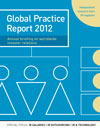 While IR Magazine has been doing surveys of investors, analysts and IR officers for many years, we decided to build on that process in 2010 by creating a dedicated IR research unit: IR Insight. Since then, IR Insight has managed our awards research of investors and analysts, as well as conducting huge surveys of investor relations professionals around the world to find out how you all do IR and what you think about the profession. While IR Magazine has been doing surveys of investors, analysts and IR officers for many years, we decided to build on that process in 2010 by creating a dedicated IR research unit: IR Insight. Since then, IR Insight has managed our awards research of investors and analysts, as well as conducting huge surveys of investor relations professionals around the world to find out how you all do IR and what you think about the profession. The latest publication by IR Insight – the IR Magazine Global Practice Report 2012 – is based on the views of 1,411 IR practitioners globally. The report covers areas including budgets, salaries, outsourcing, team size and even smartphone use on a worldwide and regional basis. It also compares key data by sector to show, for example, that the basic materials sector has, on average, some of the smallest IR team sizes but some of the biggest budgets. |
October 2007: Ready for the fall?
The US housing market had gone pop and now everyone was waiting to see what would happen next. A sense of foreboding hung over the market: even though stocks had already fallen substantially, people felt they had further to go (and, of course, they were right). ‘I’m just glad we’re private now,’ commented Mark Kimbrough, vice president of IR at hospital operator HCA.
The message from veterans of past crises was to keep communicating. ‘It’s hard to be relaxed when your share price is falling, but you have to take a step back and get perspective,’ said George Stinnes, head of IR at British Airways. ‘I have not changed what I’m doing at all from an IR standpoint.’
April 2009: State capital
We (well, most of us) enjoyed watching the bankers responsible for causing the worst financial crisis for a generation get hauled in front of politicians in the UK and the US for a thorough grilling.
As our cover story pointed out, though, the sight of bankers being told off like naughty school children belittled the magnitude of events: governments had moved to nationalize a number of banks to prevent them from failing, handing politicians huge power over of some of the world’s largest corporations.
Investors soon began to accuse governments of acting counter to the interests of other shareholders and exercising too much control over strategy. It was an extremely challenging time for any IR professional stuck in the middle. 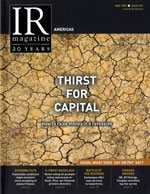 May 2009: Thirst for capital
May 2009: Thirst for capital
After the banking crisis came the credit crunch. Company after company went cap in hand to the markets asking for fresh funds. One of the biggest cash calls saw HSBC raise £12.5 bn ($18.5 bn at the time) in a rights issue.
Finding themselves in a strong position, institutional investors took a hard line with companies and pushed for changes in strategy, management and corporate governance. Hermes Equity Ownership Services told IR Magazine it was ‘a prime opportunity’ for investor action.
Fund-raising methods also came under scrutiny. In countries like the UK where pre-emption rights are protected under law, companies were criticized for using inventive financial structures – such as the so-called cash-box transaction – to circumvent the need for shareholder approval.
July 2009: On the road again
Corporate access had traditionally been dominated by the bulge-bracket investment banks. With share trading falling and commission payments down, however, a large number of other players were jumping into the market, keen to grab a piece of the lucrative payments on offer for setting up meetings between companies and investors. Each meeting could be worth between $5,000 and $20,000, according to one estimate.
The change had positives and negatives for the investor relations profession. On the positive side, there was suddenly more choice – brokers were falling over themselves to take companies on the road, and you could be a lot more demanding in terms of who you wanted to see. On the other hand, all that demand made it much more difficult to keep all of your analysts happy.
August 2009: Gearing up
Debt became far more important to IR professionals in the aftermath of the financial crisis. Equity investors started to act like their bond colleagues, less concerned with sales and earnings and more interested in cash flow and whether a company could survive as a going concern.
One company ahead of the game was BMW. The car manufacturer had already placed a permanent debt spokesperson in the IR team to help communicate with investors about the company’s growing car-leasing business. This process accelerated with the onset of the banking crisis.
‘The crisis confirmed the value of our increased emphasis on debt investors and also assisted us in accelerating our efforts to firmly establish debt IR as part of our overall financial communications strategy,’ explained the German auto giant’s treasurer, Erich Ebner von Eschenbach.
January 2010: Enforcement smackdown
A chill spread across equity markets after regulators in the US launched an investigation into billionaire hedge fund manager Raj Rajaratnam. The SEC described Rajaratnam as ‘a master of the Rolodex’ who had built a business model around the ‘deliberate and systematic use of inside information’.
The action led IR teams and their counselors to review and reinforce disclosure practices. The best defense against leaks is more transparency, argued Jim Allen, head of capital market policy at the CFA Centre for Financial Market Integrity. Companies that ‘warehouse’ information make themselves targets for break-ins, he added.
April 2011: High-fliers: the C-suite life
Looking around, we saw an increasing number of former IROs taking seats at the top tables of public companies. A few examples were Blair Christie’s elevation to chief marketing officer at Cisco, Andrew Griffith’s appointment as CFO at BSkyB and Mark Begor’s promotion to CEO of GE Capital’s retail finance and restructuring operations.
One recruiter pointed out that IROs need to seek a broad mandate to set up a move to the C-suite, perhaps by collaborating with the CEO on a project or assuming other diverse challenges. ‘You need to break beyond the conventional box for the IR role in order to catch the eye of executives,’ he said.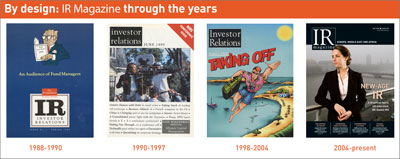
March 2012: Light at the end of the rabbit hole
At IR Magazine Think Tanks throughout Europe, north America and Asia, delegates had two consistent worries: market volatility and short-termism.
The feeling was that, after the 2008 financial crisis, markets now swung wildly around with little care for fundamentals. And the spread of high-frequency trading was making matters worse. Was there any place left for the long-term, rational investor?
An analysis by market intelligence firm Ipreo for IR Magazine found, thankfully, that the picture wasn’t so bleak. For US stocks, the proportion of trading volume made up by institutional investors had returned to pre-crisis levels. In addition, the turnover rate of the world’s active equity managers had also fallen back to where it had been in 2007. Phew!
April 2012: The good and bad of IRO 2.0
The IPO market got a much-needed boost in 2011 from a host of social media listings, such as LinkedIn, Pandora, Angie’s List and Groupon. Given the unique business models on show, we posed the question: will their IR also break the mold?
To an extent, it did. LinkedIn’s Matt Sonefeldt, for example, wasn’t your typical IRO: he came from the buy side, said he chose IR to see how a company worked from the inside, and enjoyed sharing industry news with his followers on social media. 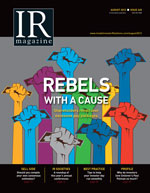 August 2012: Shareholder rebels with a cause
August 2012: Shareholder rebels with a cause
For our 25th cover, it’s fitting to end on one of the most contentious IR issues of the 21st century: say on pay. After years of letting top pay spiral out of control, shareholders finally got the courage to stand up and do something about it during the so-called ‘shareholder spring’ of 2012.
The result saw pay packets voted down across Europe and the US, including at Citi, Credit Suisse and Aviva. Other companies, like Barclays, saw large rebellions but scraped through the vote.
Why did shareholders decide to take action? Our cover story underlined the combination of political and media pressure, safety in numbers, the creation of say-on-pay votes in the US, and plain disgust at sky-high pay for lamentable performance.










